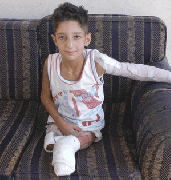
|
| Twelve-year-old Mohamed Samer Elhaz Mouss, photographed in October 2006, was injured by Israeli cluster bomblets delivered by Israeli warplanes during the Israeli aggression on Lebanon. |
Most residents here have traditionally depended on agriculture to provide for their families. But instead of sowing crops or herding their flocks through the grassy terrain, for the last five years locals have viewed the surrounding hills with caution. Lurking in these fields are hundreds of thousands of cluster munitions, silently waiting to claim their next victim.

|
| Israel flooded the south of Lebanon with millions of cluster bombs towards the end of the 2006 war on Lebanon and after UN resolution 1701 was passed, in an attempt to prevent Lebanese residents from returning to their homes in that area, according to Lebanese government reports. |
Lebanon was among the first countries to sign the convention in December 2008 and although it only entered into force in May this year, officials have been keen to take an international leadership role on its implementation. This week Beirut hosts the second international meeting of states parties to the Convention. Delegates from over 110 governments, UN and other international organizations will attend the week-long conference along with survivors of cluster munitions to discuss how to further advance the Convention’s obligations.






Leave a Reply